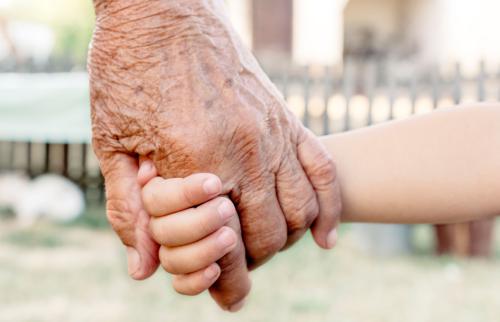Executive Summary
- Around 1 million children in the U.S. live with a grandparent caregiver, defined as a grandparent who lives with their grandchild, is responsible for meeting the grandchild’s basic needs, and does not live with the parent of the grandchild.
- Over time, the child welfare system has placed greater emphasis on placing foster children with relative caregivers, including grandparents.
- While caring for a grandchild can come with benefits—including a sense of purpose, an opportunity to pass on cultural heritage, and companionship—it may also come with challenges.
- Compared to parent-led families, grandparent caregiver families face higher rates of poverty and are more likely to include a child or household member with a disability.
- Grandparent caregivers have worse mental health on average than non-caregiving grandparents.
- Many grandparent caregiver families rely on safety net programs for cash assistance, nutrition assistance, and health insurance, but they face unique barriers to accessing and navigating these benefits.
- Legal guardianship or custody requirements or perceived requirements prevent some grandparent caregivers from accessing benefits.
- State-level kinship navigator programs help connect grandparent caregivers to safety net benefits and other services.
- We highlight three areas where policymakers could strengthen support for grandparent caregiver families:
- Reduce barriers for grandparent caregiver families to qualify for and navigate Social Security and other safety net programs.
- Leverage federal funding from the National Family Caregiver Support Program for mental health and respite care.
- Improve the ability of surveys and data systems to collect information on grandparent caregiver families.
What is a grandparent caregiver family?
About a million children in the United States live with a grandparent caregiver. Though grandparents can be involved in caring for grandchildren in a variety of living arrangements, here we define grandparent caregivers narrowly as grandparents who live with their grandchildren under age 18, are responsible for meeting the grandchildren’s basic needs, and do not live with the grandchildren’s parents. By this definition, the share of children living with a grandparent caregiver has hovered around 1.4% for the past two decades. Many of these are long-term arrangements: In 2023, almost 60% of grandparent caregivers had been caring for their grandchildren for 5 or more years.
Children live in households with their grandparents for a variety of reasons. In multigenerational households, which are not the focus of this report, the decision for children and their parents to live with grandparents is often related to cultural norms, caregiving needs, or financial issues. In contrast, children often enter arrangements in which their grandparents are their primary caregivers due to difficult life events, including parental incarceration, death, economic struggles, and substance abuse issues. For example, recent research has found that the opioid crisis has contributed to the growing share of children living away from their parents or in a grandparent-led household over the past three decades.
Grandparent caregiving arrangements take many forms. Some grandparents are licensed foster parents through the child welfare system, some receive support from a child welfare system kinship program but are not licensed foster parents, and others raise their grandchildren independent of the child welfare system. Figure 1 shows the overlap of children in foster and kinship care. In 2022, one third of children in the foster care system were placed with relatives. However, children placed in foster family homes with relatives make up just 5% of the 2.5 million children who are living away from their parents and with other relatives. Most children in kinship care outside of the foster system are being cared for by their grandparents.
Grandparent caregivers who have a legal relationship (adoption, guardianship, or custody) to their grandchild have fewer barriers to accessing support. However, establishing a legal relationship can be complex and sometimes undesirable. With adoption, the birth parents’ rights to their children are terminated, which may be too permanent a decision for those who hope that the children’s birth parents will be able to care for them again. Grandparents who do not wish to adopt can pursue legal custody or guardianship, depending on the legal relationship options available in their state. These relationships grant them the legal authority to make decisions about their grandchildren’s health, education, and welfare, but take time and money to obtain, and the parents can petition the court to regain custody. A temporary or limited guardianship arrangement may be an option for families who plan for the parents to eventually resume parenting, but it may limit some of the decisions that grandparents can make about their grandchildren’s care.
Who is living in grandparent caregiver families?
Using the 2006-2023 American Community Survey, we present demographic and socioeconomic characteristics of grandparent caregiver families.
In 2023, 1.4% of children in the U.S. were living with grandparent caregivers. As shown in Figure 2, the prevalence of children in such living arrangements varies by state. Children in Arkansas, Louisiana, and Mississippi are the most likely to live with grandparent caregivers, with over 3% of all children living in this arrangement, while children in Minnesota, New Jersey, and Oregon are the least likely to live with a grandparent caregiver.
Grandparent caregiver families are more likely to be socioeconomically disadvantaged than parent-led households, as shown in Figure 3. Thirteen percent of children living with grandparent caregivers grow up in deep poverty (households with income less than 50% of the federal poverty level), compared to 8% of children living in a parent-led household without grandparents present. Children in grandparent caregiver families are more than twice as likely to be disabled (10%, compared to 4% in parent-led households), and these disabilities are commonly related to cognitive impairments and mental health as opposed to physical limitations. The children are also more likely to live with someone who has a disability because grandparent caregivers experience higher rates of disability than parents of children under 18. Grandparent caregiver families also have lower educational attainment on average: 56% of children in grandparent caregiver families live with an adult who has no more than a high school education, compared to 30% of children in parent-led households.
Less than half of grandparent caregivers are employed, but employment varies considerably with age, as shown in Figure 4. Most grandparent caregivers below age 62 are employed, but employment rates drop considerably for those ages 62 and above (i.e., those eligible for old-age Social Security benefits). About half of grandparent caregivers are too young to retire, and others postpone their retirement plans due to the financial pressures of caregiving. Moreover, some may choose to come out of retirement to support their grandchildren’s needs.
Given the prevalence of single motherhood and gendered caregiving norms, grandparent caregiving is more prevalent among women than men. As shown in Figure 5, almost half of children being raised by grandparent caregivers live in a household with just a grandmother caregiver, 43% of children in grandparents’ care are being taken care of by two grandparents, and just 9% of children were with their grandfathers.
As shown in Figure 6, the average and median age of grandparent caregivers in 2023 is 62. The same is true for grandparent caregivers living in poverty. Grandmother caregivers tend to be younger than grandfather caregivers, with a median age of 62 versus 65. Age is relevant because some safety net programs have age eligibility restrictions. For example, intergenerational housing assistance is for caregivers who are 62 years or older, and early claiming for old-age Social Security also starts at 62, rendering about half of grandparent caregivers ineligible for these programs.
Grandparent caregiving arrangements differ significantly by race and ethnicity. As shown in Figure 7, grandparent caregiving arrangements are most common for American Indian and Alaska Native (AIAN) children. AIAN children have had the largest increase in grandparent living arrangements over the last two decades: 4.8% of AIAN children were living with grandparent caregivers in 2023, up from 3.3% in 2006. Kinship care (situations in which children live with relatives or close friends known as fictive kin) and grandparent living arrangements in AIAN communities are common due to a long-standing cultural tradition of extended family kinship structures, as well as destabilizing factors including unemployment, mental health struggles, and substance abuse. Black children are also more likely to live with a grandparent caregiver than the general population, though the share declined between 2006 and 2023. Among Black communities, too, kinship care is an age-old cultural tradition, and in recent decades, drug epidemics and hurricanes have contributed to the formation of Black grandparent caregiver households.
In the remainder of this report, we examine grandparent caregivers’ relationship to the child welfare system, their access to the social safety net, and how public policy can better support grandparents and children in these arrangements.
Relative caregivers and the child welfare system
Children typically enter foster care, a system of temporary living arrangements monitored by state or local child welfare agencies, when their home environment is unsafe. Children in the foster care system can be placed with either relative or non-relative foster families, in group homes, or in other arrangements, depending on their circumstances.
Over time, a growing share of children in the foster system have been placed with relatives. Figure 8 shows the share of foster children placed with relatives over the last two decades. Between 2000 and 2010, the fraction of children in the foster care system placed with relatives hovered around 25%. By 2022, relative placements had risen to 34%. Placement with relatives also varies substantially by state (though states differ in how they collect and report these data): half of all children in foster care were placed with relatives in West Virginia and Arizona, while this share was less than 15% in Kentucky, Virginia, and Tennessee.
The rising trend of relative placements is in part owed to legislative action and regulations at the federal and state levels, beginning with the Indian Child Welfare Act (ICWA) of 1978. The U.S. government has a long history of attempts to forcibly assimilate AIAN children, which included unnecessary removals from their homes and communities. The ICWA was enacted to counter these practices, setting minimum federal standards to protect AIAN children in the child welfare system and strive to keep them connected to their families and cultures. While this law only applies to children who are members of federally recognized tribes (or whose parents are members of such tribes), child welfare advocacy organizations see its emphasis on family placement as best practice for all children, regardless of race or tribal affiliation. Indeed, federal child welfare law has come to align more closely with the ICWA in the decades following its enactment.
The 1996 Personal Responsibility and Work Opportunity Reconciliation Act (PRWORA) requires that states consider placing children with adult relatives over non-related caregivers when possible. The 2008 Fostering Connections to Success and Increasing Adoptions Act further requires that child welfare agencies identify and notify adult relatives when a child is removed from their home. States, tribes, and territories must comply with this guidance in order to use federal funds from Title IV-E of the Social Security Act for foster care, guardianship, and adoption assistance.
The Family First Prevention Services Act, passed as a part of the Bipartisan Budget Act of 2018, includes funding for programs to better support kin caregivers and children in (or at risk of being in) the foster care system. One provision, known as the Title IV-E Prevention Services Program, covers costs related to preventing entry into the foster care system, and kinship navigator programs. Kinship navigator programs connect caregivers to safety net benefits, aid in establishing legal relationships with children, and help families transition to new caregiving arrangements. Some programs exclusively serve families in the child welfare system, while others are open to all kinship families because they aim to prevent foster care entry. Kinship navigator programs now exist in almost every state.
Since these laws promoting relative placement were enacted, research has found that children fare better when placed with relatives than those placed with non-relatives. Children placed with grandparents in foster care have better academic performance, may be less likely to experience placement disruption (the premature ending of a foster care placement), and may have fewer behavioral problems and mental health disorders compared to non-relative placements. For example, parental incarceration negatively impacts children’s well-being and development, but placement with grandparents during a parent’s incarceration can give children a stable environment to grow up in.
In order for a foster child to be placed with their relatives, those relatives may need to become licensed by the state to ensure they meet health and safety standards (as is true for all foster parents). However, this can pose a barrier to kinship care because relatives may struggle to meet licensure requirements, such as minimum bedroom square footage requirements. Licensure also determines whether relative caregivers can access public assistance through child welfare agencies. In all but 13 states, relative caregivers not licensed as foster parents are not eligible for foster care payments, which are more generous than payments from the traditional Temporary Assistance for Needy Families cash welfare program.
In 2023, the U.S. Department of Health and Human Services (HHS) issued an amended rule that allows title IV-E child welfare agencies to implement different licensing care standards for relative versus non-relative caregivers. The 2023 rule also required that licensed kin caregivers receive the same amount in foster care maintenance payments as relative foster families. In 2024, Michigan became the first state to implement new, simplified licensing standards for kin caregivers, allowing Michigan relative foster parents to access greater financial resources, and several other states and territories have made similar plans.
Grandparent caregivers’ access to safety net programs
Given that grandparent caregiver families face higher rates of poverty than parent-led families, it is essential that they have access to safety net programs. Unfortunately, the safety net is difficult to navigate in general, and it can be especially challenging for grandparent caregivers. Research shows that grandparent caregivers suffer from both perceived and real obstacles in accessing safety net programs.
In a 2013 survey, 21% of relative caregivers said they found it “somewhat or very difficult” to obtain public assistance. The same survey found that 15% of children were living with relative caregivers who weren’t aware of what services were available to them in their community, highlighting the need for further outreach.
Much of the confusion around their safety net eligibility relates to the legal relationship between a child and their grandparent caregiver. Grandparents sometimes receive conflicting information about legal custody that may deter them from applying for safety net programs, even if program rules don’t require a specific legal relationship. A 2015 study of African American grandmother caregivers found that many of them struggled to access cash welfare because they received misinformation about legal relationship requirements. For other programs, such as state and local housing subsidies, housing authorities may require a legal relationship (though this is not permitted by federal law).
In the following subsections, we provide an overview of the key components of the safety net that support grandparent caregiver families.
Temporary Assistance for Needy Families
Temporary Assistance for Needy Families (TANF) is a time-limited cash assistance program for low-income families, replacing Aid for Families with Dependent Children (AFDC) in 1996. TANF is administered as a block grant to the states, leaving benefit levels and eligibility largely to states’ discretion. Since the 1996 law, the share of families in poverty receiving TANF benefits fell from 68% in 1996 to 21% in 2020, with many states directing funds to other services and non-cash forms of support.
TANF has two grant types that support families in poverty: the family grant and the child-only grant. Eligibility for the family grant is based on family size, income, and assets, and typically comes with work requirements, though there are exceptions—West Virginia exempts all grandparents and non-parental caregivers from work requirements, for example, while Texas has work requirement exemptions for single grandparents over 50 years old caring for a child under three years of age.
TANF child-only grants accounted for almost half of all TANF cases in FY 2023, and nearly one in four child-only grant recipients had a grandparent caregiver. Child-only grants are given when a relative caregiver is raising the child without a parent present in the home and that caregiver is ineligible for TANF, often due to receiving Supplemental Security Income or being a non-citizen. Only children are included in the benefit calculation for the TANF child-only grants, meaning that benefits are lower, and they generally do not have work requirements. In FY 2023, the monthly average for the family grant was $650, compared to $566 for the child-only grants.
When custodial grandparents apply for TANF benefits, they typically must cooperate with the child support program and assign their right to child support from non-custodial parents to the state—that is, the child support payments that would have otherwise gone to the custodial grandparent are now owed to the state, which splits them with the federal government to recover program costs. Federal TANF law and policy allow for a “good cause” exemption to assigning child support, and some states make use of that exemption while others do not. In 2021, Massachusetts updated its good-cause exemption rules to exempt all kin caregivers from cooperation, and Wyoming followed with a similar policy.
Supplemental Nutrition Assistance Program (SNAP)
The Supplemental Nutrition Assistance Program (SNAP), previously the Food Stamp program, is a federally funded food assistance program. SNAP benefits are administered at the state level, and recipients are given an electronic benefit transfer (EBT) card to purchase groceries. According to the U.S. Department of Agriculture (USDA), a SNAP household consists of everyone who lives and purchases meals together, and establishing legal custody or guardianship is not necessary to be eligible for SNAP.
Despite the broad “household” definition, there is still some confusion about SNAP access among non-parental caregivers. Stigma, misconceptions around eligibility, difficulty reaching SNAP offices, and other barriers make it difficult for older adults in particular to apply for SNAP benefits. Additionally, Social Security income and retirement savings count toward the SNAP income and asset limits, penalizing some grandparent caregivers who have saved for retirement but may still struggle to support their grandchildren.
Families with grandparents and other relative caregivers may be eligible for additional food assistance programs. For school-aged children, participation in SNAP confers eligibility for free school lunch. The WIC program (Special Supplemental Nutrition Program for Women, Infants and Children) is also open to grandparents and relative caregivers taking care of children under age 5. Grandparents looking to apply for WIC must meet income requirements and show that their grandchild is in their care, but as with SNAP, they need not have legal custody or guardianship of their grandchild.
Health insurance coverage
Due to their high rates of poverty and the fact that just half of grandparent caregivers are employed, most individuals in grandparent caregiver families rely on public health insurance through Medicaid, the Children’s Health Insurance Program (CHIP), or Medicare. Medicaid is the largest single source of health insurance coverage, providing coverage to low-income populations. Children in grandparent caregiver families are categorically eligible for Medicaid if they receive Title IV-E foster care maintenance payments, kinship guardianship assistance, or adoption assistance payments. Participation in other safety net programs, such as TANF or Supplemental Security Income, may also confer Medicaid eligibility. Children with family incomes too high to qualify for Medicaid but too low to afford private coverage are often eligible for CHIP. Though grandparents 65 and older are eligible for Medicare, this does not confer insurance for their grandchildren.
For grandparent caregivers with private health insurance, coverage typically only applies to their grandchildren if the grandparent has adopted them. Employer-sponsored health insurance is the most common form of health coverage for those under age 65, but in 2023, 40% of grandparent caregivers under age 65 were not employed, preventing them from accessing this form of coverage.
Beyond securing health insurance coverage, grandparent caregivers must also obtain legal authority to manage the child’s health care. In general, relative caregivers cannot consent to health care on a child’s behalf if they have not established legal custody or guardianship over the child. Some states have enacted medical consent laws that give grandparents and other relative caregivers the authority to make health care decisions for a child, even without legal custody. California, for example, offers a Caregiver Authorization Affidavit that permits relatives to enroll children in school and consent to health care, but non-relative kin caregivers can only consent to school-related medical decisions (e.g., vaccinations and physical exams). Advocates recommend that state policymakers create and amend medical consent laws to ensure that children in kinship care can access all essential health care.
Support from the tax system
The Earned Income Tax Credit (EITC) and the Child Tax Credit (CTC) are federal tax credits that encourage work and support families with children, including grandparent caregiver families. The benefit amount for both tax credits is determined by an individual’s earnings (which must be positive), marital status, and number of children.
Grandparent caregivers can access the EITC and CTC similarly to parents. They need not establish legal custody or guardianship to claim either credit—grandchildren can be counted as a qualifying child if they have lived with their grandparent for more than half of the year, did not provide more than half of their own support, and met the age and citizenship requirements. The EITC has an upper age limit of 65 for childless adults, but this doesn’t apply to grandparents and other caregivers with a qualifying dependent.
Grandparent caregivers who wish to adopt their grandchild are also eligible for an adoption-related, non-refundable tax credit. In 2024, families could claim a credit for up to $16,810 of adoption-related expenses over a five-year period.
Social Security and Supplemental Security Income
The Old-Age, Survivors, and Disability Insurance (OASDI), commonly known as Social Security, is a federal benefits program for retired, disabled, and deceased workers and their families. In June 2025, 69.8 million individuals received Social Security benefits, with payments averaging around $1,900 per month. Additional payments are added to the benefits package if the Social Security beneficiary has a child who is under 18, in elementary or secondary school, or disabled. Grandchildren sometimes receive assistance from Social Security if their grandparent caregiver retires or enters a period of disability. To receive these benefits, the grandparent must adopt their grandchild, or the child’s parents must be either deceased or disabled. Children with deceased parents are also eligible for Social Security survivor’s benefits.
The Social Security Administration also administers Supplemental Security Income (SSI) benefits for low-income individuals who are over age 65, blind, or disabled. In June 2025, 7.4 million individuals received SSI payments, including almost 1 million children.
Each year, about 27,000 children in the foster care system receive Social Security benefits due to the death, disability, or retirement of an insured parent, or SSI due to their own blindness or disability. Foster children who receive Social Security or SSI are assigned a “representative payee” who manages the benefits on their behalf. It is the payee’s responsibility to ensure the benefits are used in the child’s best interest—that is, to pay for shelter, food and other necessities.
The Social Security Administration allows child welfare agencies to be listed as payees but places relative caregivers ahead of them in preference. Relative caregivers who don’t have custody of children are still given higher preference as a representative payee than child welfare institutions, even in cases in which the foster care agency has legal custody. Further, if an agency files to be the representative payee for a child, but a relative visits a Social Security field office and demonstrates a willingness to care for the child, they can instead be assigned as the payee, even without legal custody. Despite the preference for relatives, eight out of ten children receiving Social Security and SSI in foster care have a child welfare agency assigned as the representative payee. In FY 2018, child welfare agencies collected nearly $179 million in Social Security and SSI benefits to cover the cost of foster care.
Advocates have criticized child welfare agencies’ use of children’s Social Security and SSI funds to reimburse themselves for the cost of foster care. A Government Accountability Office report found that in 2020, 42 of 50 child welfare agencies used Social Security benefits to reduce foster care costs. The Social Security Administration and HHS issued a reminder to state agencies that Social Security benefits must be used for child’s current needs and the excess must be conserved for their future. For children with disabilities, one option for conservation without affecting SSI eligibility is the Achieving a Better Life Experience (ABLE) account, a tax-advantaged savings account that doesn’t count against the SSI resource limit.
Grandparent caregivers’ access to health insurance, SNAP, and TANF
Due to their unique family circumstances, grandparent caregivers’ experiences navigating the social safety net may differ from those of parent-led families, especially older grandparents and grandparents who have entered new caregiving arrangements. Using the 2006-2023 American Community Surveys, we analyze program participation rates in SNAP, TANF, and public health insurance among children with grandparent caregivers who live below the poverty line.
As shown in Figure 9, conditional on being in poverty, children in parent-led and grandparent caregiver families have similar rates of receiving SNAP and public health insurance, but children in grandparent caregiver families are more likely to be in a household receiving TANF payments.
Figure 10 shows that access to safety net programs expands as the length of a grandparent caregiving arrangement increases. 55% of children living in poor grandparent caregiver families for less than six months were in a SNAP household, and this share increases to 64% for children in poor grandparent caregiver families for five or more years. Household participation in TANF and children’s enrollment in public health insurance are also higher for poor households in longer-term grandparent caregiver arrangements.
Grandchildren’s participation in safety net programs also differs by the age of their grandparent caregivers. Overall, 64% of children in poor parent-led households and 62% of children in poor grandparent caregiver families were in a SNAP household. However, as shown in Figure 11, only 54% of poor children living with an older grandparent caregiver (aged 62 or over) were in a SNAP household. TANF participation, too, is lower among older grandparent families living in poverty, relative to all poor grandparent caregiver families.
Policy implications
There are three key areas in which policymakers could improve support for grandparent caregiver families: 1) easing the process of qualifying for safety net programs, 2) expanding mental health and respite services, and 3) improving data collection.
One way to allow safety net benefits to reach more grandparent caregiver families is to relax Social Security’s legal guardianship requirements. Currently, Social Security benefits are only available to legal dependents of Social Security beneficiaries, meaning that grandparent caregivers must formally adopt their grandchildren in order for their grandchildren to receive benefits. Conversely, the IRS allows grandparents to claim their grandchildren as dependents if they have provided half of the child’s support and the child has lived in their household for half the year, regardless of their legal relationship. If the Social Security eligibility criteria were relaxed to parallel the IRS’s definition of a dependent, nearly half of grandparent caregiver households would qualify for child Social Security, adding an average of $8,100 to their annual benefits (a 42% increase). A recent Brookings proposal suggests loosening eligibility rules to facilitate Social Security support of grandparent caregiver families. The Grandfamilies & Kinship Support Network also offers suggestions for states to make their TANF programs more accessible for kinship families.
At the state level, policymakers could leverage federal funding for mental health and respite services for grandparent caregivers. While there are meaningful benefits to raising one’s grandchild, grandparent caregivers have worse mental health outcomes on average than their non-caregiving counterparts. The National Family Caregiver Support Program (NFCSP), created under the Older Americans Act, provides grants to states and territories to support relative caregivers of children, but some states and Area Agencies on Aging are not fully utilizing this program. These supports include assisting caregivers in accessing services; providing counseling, training, and peer-to-peer support groups; and respite care that temporarily relieves family members from their caregiving responsibilities. For example, in Michigan’s Ingham, Eaton, and Clinton counties, the NFCSP funds the Kinship Care Respite Program, which arranges day care, summer camp, and extracurricular activities for children while their older relative caregivers take a break. Other localities that rely on NFCSP funds provide supplemental services including children’s school supplies, personalized academic plans, pro-bono legal assistance, and other in-kind gifts and services for kinship families.
To understand the wellbeing and needs of grandparent caregiver families, they must be better identifiable in data. Currently, most analyses of grandparent caregiver families and kinship families using Census data is inferred from the relationships between family members in a household. Although a useful method of counting kinship families, it doesn’t fully capture the nuances of these relationships. More comprehensive data collection could include questions about whether relatives other than grandparents or fictive kin are the primary caregivers of children, whether kinship care arrangements are within or outside of the foster care system, how much families receive in foster care payments, and whether families have connected with kinship navigator programs, to name a few.
Identifying grandparent caregiver families also requires that the caregivers recognize themselves as such. A 2022 report from the Recognize, Assist, Include, Support, and Engage (RAISE) Family Caregiving Advisory Council found that many people caring for their relatives don’t think of themselves as “caregivers” and instead see their responsibilities as part of being a dedicated spouse, child, or grandparent. Failing to recognize oneself as a caregiver can both hamper data collection efforts and inhibit access to resources. The RAISE and the Support Grandparents Raising Grandchildren Advisory Councils encourage coordination between state entities, school districts, health providers, and more to launch outreach campaigns that raise awareness about caregiver families. Here, and with any services affecting grandparent caregiver families, it is important to engage with caregivers themselves in the design and implementation process.
Grandparents play an important role in families and many children’s lives. They pass on their cultural heritage and history to their grandchildren, provide child care, and positively impact grandchildren’s educational outcomes. Although children in grandparent caregiver families often come into these arrangements through adverse circumstances, living with grandparents and other relatives has proved to be positive for children’s outcomes. Given the unique circumstances that create grandparent caregiver families, as well as the challenges faced by both caregivers and children in these households, research and policy discussions ought to include special considerations for kinship care and grandparent caregiver families’ needs.
The Brookings Institution is committed to quality, independence, and impact.
We are supported by a diverse array of funders. In line with our values and policies, each Brookings publication represents the sole views of its author(s).










